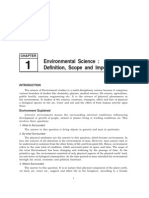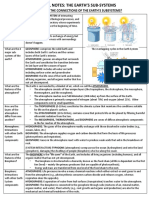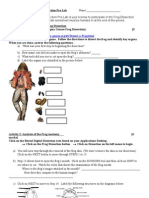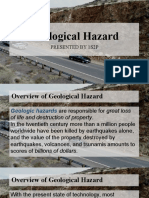0 ratings0% found this document useful (0 votes)
120 viewsMineral Resources 3rd
Mineral Resources 3rd
Uploaded by
corazonThe document discusses minerals and their importance in society. It defines key terms like mineral occurrence and deposit. It describes how different types of mineral resources like magmatic, hydrothermal, and sedimentary deposits are formed through geological processes. It explains how mineral exploration and different mining methods like surface and underground are used to find and extract minerals. It outlines milling processes to separate minerals from waste, including magnetic separation and flotation. It notes environmental impacts of irresponsible mining like erosion, sinkholes, and contamination, and asks what solutions might exist.
Copyright:
© All Rights Reserved
Available Formats
Download as PPTX, PDF, TXT or read online from Scribd
Mineral Resources 3rd
Mineral Resources 3rd
Uploaded by
corazon0 ratings0% found this document useful (0 votes)
120 views36 pagesThe document discusses minerals and their importance in society. It defines key terms like mineral occurrence and deposit. It describes how different types of mineral resources like magmatic, hydrothermal, and sedimentary deposits are formed through geological processes. It explains how mineral exploration and different mining methods like surface and underground are used to find and extract minerals. It outlines milling processes to separate minerals from waste, including magnetic separation and flotation. It notes environmental impacts of irresponsible mining like erosion, sinkholes, and contamination, and asks what solutions might exist.
Original Description:
mineral
Copyright
© © All Rights Reserved
Available Formats
PPTX, PDF, TXT or read online from Scribd
Share this document
Did you find this document useful?
Is this content inappropriate?
The document discusses minerals and their importance in society. It defines key terms like mineral occurrence and deposit. It describes how different types of mineral resources like magmatic, hydrothermal, and sedimentary deposits are formed through geological processes. It explains how mineral exploration and different mining methods like surface and underground are used to find and extract minerals. It outlines milling processes to separate minerals from waste, including magnetic separation and flotation. It notes environmental impacts of irresponsible mining like erosion, sinkholes, and contamination, and asks what solutions might exist.
Copyright:
© All Rights Reserved
Available Formats
Download as PPTX, PDF, TXT or read online from Scribd
Download as pptx, pdf, or txt
0 ratings0% found this document useful (0 votes)
120 views36 pagesMineral Resources 3rd
Mineral Resources 3rd
Uploaded by
corazonThe document discusses minerals and their importance in society. It defines key terms like mineral occurrence and deposit. It describes how different types of mineral resources like magmatic, hydrothermal, and sedimentary deposits are formed through geological processes. It explains how mineral exploration and different mining methods like surface and underground are used to find and extract minerals. It outlines milling processes to separate minerals from waste, including magnetic separation and flotation. It notes environmental impacts of irresponsible mining like erosion, sinkholes, and contamination, and asks what solutions might exist.
Copyright:
© All Rights Reserved
Available Formats
Download as PPTX, PDF, TXT or read online from Scribd
Download as pptx, pdf, or txt
You are on page 1of 36
Objectives:
• Identify the importance of minerals in
our society.
• Describe how minerals are formed,
found, mined, and processed for
human use.
• Cite ways to prevent or lessen
environmental impact that result from
the exploitation, extraction, and use of
mineral resources.
A. Minerals in Our
Everyday Life
B. Significant Terms
• Mineral Occurrence- concentration of a mineral that
is scientific or technical interest.
• Mineral Deposit- mineral occurrence of sufficient
size and grade or concentration on to enable
extraction under the most favorable conditions.
• Ore Deposit- mineral deposit that has been tested
and known to be economically profitable to mine.
• Aggregate- rock or mineral used as filler in cement,
asphalt, plaster etc. (a.k.a. “nonmetallic deposits”
• Ore- natural occurring material from w/c a mineral
or minerals of economic value can be extracted.
DIFFERENT TYPES OF
MINERAL RESOURCES
Occurrence of
Mineral
Resources
How are they Formed?
• The geological process involved in the
rock cycle plays a major role in the
accumulation and concentration of
valuable elements/ minerals.
• Plate Tectonics: the Earth’s crust is broken
into a dozens or more plates of different
sizes that move relatively one to another
(lithosphere). These plates are moving
slowly on top of a more mobile material
called “asthenosphere”.
Different Mineral Resources
and Their Origin
1. Magmatic Ore Deposits
Valuable are concentrated within
igneous body through magmatic process
such as crystal fractionation, partial
melting, and crystal settling.
Different Mineral Resources
and Their Origin
2. Hydrothermal Ore Deposits
Concentration of valuable
substances by hot
aqueous(water-rich) fluids flowing
through fractures and pore-spaces in
rocks.
Different Mineral Resources
and Their Origin
3. Sedimentary Ore Deposits
Some valuable substances are
concentrated by chemical
precipitation coming from lakes or
seawater.
Different Mineral Resources
and Their Origin
4. Placer Ore Deposits
Deposits formed by
concentration of valuable substances
through gravity separation during
sedimentary processes.
Different Mineral Resources
and Their Origin
5. Residual Ore Deposits
A type of deposit that results
from accumulation of valuable
materials through chemical
weathering processes.
How are they found?
A. Mineral Exploration
-a sequential process of information
gathering that assesses
the mineral potential of a given area. It
starts with an idea or geologic model that
identifies lands worthy of
further exploration. Suitable target areas
may then be staked as mineral claims to
secure the mineral rights.
B. Mining
Methods
1. Surface Mining
Utilized to extract ore
minerals that are close to
Earth’s surface. It include open
pit mining, quarrying, placer
mining, and strip mining.
2. Underground Mining
Utilized to extract ore
minerals from the orebody is
that is deep under Earth’s
surface.
C. Milling Process
Recovering the
minerals from the waste
area and waste materials can
involve one or more
processes wherein the
preparation is usually done
in the mill.
1. Heavy Media Separation
The crushed rocks are
submerged in liquid where the
heavier/denser minerals sink thus
are separated from lighter
minerals. This is commonly used to
separate chalcopiryte from the
quartz before the refining process
of extracting copper.
2. Magnetic Separation
If the material or
mineral is magnetic, e
crushed ore is separated
from the waste materials
through the use of
powerful magnet.
3. Flotation
The powdered ore is
placed into agitated and
frothy slurry where some
minerals and metals based on
physical and chemical
properties may either sink to
the bottom or may stick to
the bubbles and rise to top
thus separating the minerals
and metals from the waste.
4. Cyanide Heap Leaching
This method is used for low-
grade gold ore where the crushed
rock is placed on “leached-pile”
where cyanide solution is sprayed
or dripped on to of the pile. As the
leach solution is percolates down
through the rocks, the gold is
dissolved into the solution. The
solution is processed further to
extract gold.
D. Environmental Impact of
Irresponsible Mining:
• Erosion
• Sinkholes
• Loss of Biodiversity
• Contamination of water and
land.
• Negative effect on air quality
(carbon emission)from mining processes.
WHAT MIGHT BE THE
SOLUTION??
You might also like
- Minor PT 2 Rock Cycle Lab Home ExperimentDocument6 pagesMinor PT 2 Rock Cycle Lab Home ExperimenthilaryNo ratings yet
- Mineral Properties WorksheetDocument5 pagesMineral Properties Worksheetbkberkowitz33% (3)
- ROCKS.1st Quarter.Document48 pagesROCKS.1st Quarter.Nena AbasoloNo ratings yet
- Lesson 2 Principles of StratigraphyDocument31 pagesLesson 2 Principles of StratigraphyApple Mae AlegriaNo ratings yet
- 4 Mineral ResourcesDocument47 pages4 Mineral ResourcesMin KrNo ratings yet
- Earth-Science-exogenic ProcessesDocument33 pagesEarth-Science-exogenic ProcessesKc MandingNo ratings yet
- 5 - 18b - Mineral ResourcesDocument90 pages5 - 18b - Mineral ResourcesDa Apollyon100% (4)
- Group 5Document30 pagesGroup 5Kim TaehyungNo ratings yet
- Earth-Science w2 l2 q2 MetamorphismDocument35 pagesEarth-Science w2 l2 q2 MetamorphismCj Padata100% (1)
- Reviewer Earth SciDocument5 pagesReviewer Earth SciJR GamerNo ratings yet
- BS Geology CurriculumDocument2 pagesBS Geology CurriculumJasper Solis Sunico0% (2)
- Basics of Geologic MappingDocument4 pagesBasics of Geologic Mappingthiruvin000No ratings yet
- Mineral Rock TestDocument8 pagesMineral Rock Testapi-331293056No ratings yet
- Geological HazardsDocument42 pagesGeological HazardsMarvin MelisNo ratings yet
- The Pedosphere (Soil Resources)Document24 pagesThe Pedosphere (Soil Resources)Ye JieNo ratings yet
- Landslide and Sinkhole - Part 1Document16 pagesLandslide and Sinkhole - Part 1MarC Anthony Sibbaluca100% (1)
- The Scientific Study of The Universe.: CosmologyDocument25 pagesThe Scientific Study of The Universe.: CosmologyJackNo ratings yet
- Three Types of RockDocument28 pagesThree Types of Rockmsshapirorm110100% (1)
- Environmental ScienceDocument9 pagesEnvironmental ScienceilyaskureshiNo ratings yet
- Earth'S Materials and Processes: Marilyn P. MifuelDocument57 pagesEarth'S Materials and Processes: Marilyn P. MifuelSheyah Villanueva100% (1)
- Earth Materials and Processes, Lesson 5Document13 pagesEarth Materials and Processes, Lesson 5Bayoyong NhsNo ratings yet
- Biological MacromoleculesDocument34 pagesBiological MacromoleculesRosemarie Joy TanioNo ratings yet
- Geological FoldsDocument66 pagesGeological FoldsEzaz Farooq Hayat KhanNo ratings yet
- Important Minerals To SocietyDocument30 pagesImportant Minerals To SocietyBel Esguerra CabillonNo ratings yet
- Ocean BasinsDocument21 pagesOcean Basinsjared mendez100% (1)
- Module 2 Risk Factors Underlying DisastersDocument25 pagesModule 2 Risk Factors Underlying DisastersAica SanNo ratings yet
- Lecture No. 14 DEFINING AND IDENTIFYING SUBDIVISIONS OF GEOLOGIC TIME SCALE USING RELATIVE AND ABSOLUTE DATINGDocument2 pagesLecture No. 14 DEFINING AND IDENTIFYING SUBDIVISIONS OF GEOLOGIC TIME SCALE USING RELATIVE AND ABSOLUTE DATINGLucas KovesworhtNo ratings yet
- The Earths Internal HeatDocument13 pagesThe Earths Internal HeatCisca Noda RafusonNo ratings yet
- 98qtpml7v Sedimentary+RockDocument12 pages98qtpml7v Sedimentary+RockMayeee GayosoNo ratings yet
- Cornell Notes Earths Subsystem 2 Pages 1Document2 pagesCornell Notes Earths Subsystem 2 Pages 1Ericson Cec100% (1)
- Sedimentary RockDocument65 pagesSedimentary RockAbdul Moeed KalsonNo ratings yet
- Metamorphic RocksDocument33 pagesMetamorphic RocksMiguel FeijaoNo ratings yet
- The Geological Time ScaleDocument85 pagesThe Geological Time ScaleRynamae SolerNo ratings yet
- List of The Rock-Forming MineralsDocument20 pagesList of The Rock-Forming Mineralsroshan_geo07889667% (3)
- Minerals and RocksDocument42 pagesMinerals and RocksShiela Marie PanlaquiNo ratings yet
- GEO1 Week 1for UploadDocument47 pagesGEO1 Week 1for Upload[GM]ARENANo ratings yet
- Rock CycleDocument2 pagesRock CycleAngelly PereraNo ratings yet
- W 2 - EarthandLifeScience - q1 - CLAS2 - CommonRockFormingMineralsDocument15 pagesW 2 - EarthandLifeScience - q1 - CLAS2 - CommonRockFormingMineralsPeter Paul PaalanNo ratings yet
- Earth Science - Grade 11 Ola and OlcDocument6 pagesEarth Science - Grade 11 Ola and OlcDalope CstrNo ratings yet
- Frog Dissection Pre Lab 2Document4 pagesFrog Dissection Pre Lab 2bondwilderNo ratings yet
- Fossils Defining Geologic Timeline NewDocument50 pagesFossils Defining Geologic Timeline NewJames Leonard Marquez BautistaNo ratings yet
- Introduction To Different Types of Disaster PDFDocument21 pagesIntroduction To Different Types of Disaster PDFLawrence CezarNo ratings yet
- Geologic Processes - LectureDocument45 pagesGeologic Processes - LectureMARIA LOURDES MENDOZANo ratings yet
- Geological Hazard: Presented by 1S2PDocument50 pagesGeological Hazard: Presented by 1S2PTobbie LopezNo ratings yet
- EARTH SCIENCE Quarter 1 AnswersDocument26 pagesEARTH SCIENCE Quarter 1 AnswersJongseong ParkNo ratings yet
- LESSON 16 Signs of ImpendingDocument45 pagesLESSON 16 Signs of Impendinganvel aesthNo ratings yet
- Earth Science Quiz 1Document2 pagesEarth Science Quiz 1Neptune LopezNo ratings yet
- Geology Syllabus PDFDocument2 pagesGeology Syllabus PDFChristian GomezNo ratings yet
- WeatheringDocument23 pagesWeatheringyasircrNo ratings yet
- Group 4 Endogenic and Exogenic ProcessesDocument42 pagesGroup 4 Endogenic and Exogenic ProcessesPrincess PabualanNo ratings yet
- 2 How Ore Minerals Are Mined and UsedDocument45 pages2 How Ore Minerals Are Mined and UsedEsther Ruth santillanNo ratings yet
- Minerals and Rocks: Lesson 6Document38 pagesMinerals and Rocks: Lesson 6April Grace MontebanoNo ratings yet
- Prepared By: JORDAN B. ESPIRITUDocument2 pagesPrepared By: JORDAN B. ESPIRITUJordan EspirituNo ratings yet
- Chapter 3 - Natural Hazards, Mitigation and AdaptationDocument9 pagesChapter 3 - Natural Hazards, Mitigation and AdaptationAxel100% (1)
- ES Study Guide - Lesson13-Formation-and-Dating-of-RocksDocument9 pagesES Study Guide - Lesson13-Formation-and-Dating-of-RocksFrancine Yzabelle FugosoNo ratings yet
- Stratified RocksDocument26 pagesStratified RocksXyana Jezzy Alexzandra RebaulaNo ratings yet
- Earth and Life Science: Quarter 1 - Module 3: Minerals and RocksDocument42 pagesEarth and Life Science: Quarter 1 - Module 3: Minerals and RocksJoenas TunguiaNo ratings yet
- Relative and Absolute DatingDocument1 pageRelative and Absolute DatingMei NalunneNo ratings yet
- Rock Mechanics and Tunneling Course Outline: Part One Rock MechanicsDocument39 pagesRock Mechanics and Tunneling Course Outline: Part One Rock MechanicsMulugeta DefaruNo ratings yet
- Earth Science - Grade 11 Learner Activity Sheets Quarter 1 - Week 3A Title: Ore Minerals First Edition, 2021Document9 pagesEarth Science - Grade 11 Learner Activity Sheets Quarter 1 - Week 3A Title: Ore Minerals First Edition, 2021HershesntNo ratings yet
- Mahabharata Group 3Document11 pagesMahabharata Group 3corazonNo ratings yet
- Mahabharata: Stand by What's RightDocument8 pagesMahabharata: Stand by What's RightcorazonNo ratings yet
- Soil Resources: Roll No: 01315603615 Department of ChemistryDocument46 pagesSoil Resources: Roll No: 01315603615 Department of ChemistrycorazonNo ratings yet
- The Effects of CyberbullyingDocument6 pagesThe Effects of CyberbullyingcorazonNo ratings yet
- Report Text: By: Vandrektus Derek, A.MdDocument15 pagesReport Text: By: Vandrektus Derek, A.MdfakhruroziNo ratings yet
- Ggsipu 2014 Brochure - Part ADocument67 pagesGgsipu 2014 Brochure - Part AmycampusnotesNo ratings yet
- Final ConjtDocument4 pagesFinal ConjtlyNo ratings yet
- IADC Bit Types and ClassificationDocument13 pagesIADC Bit Types and ClassificationAnuranjanNo ratings yet
- RBI Credit PolicyDocument1 pageRBI Credit Policysangya01No ratings yet
- Example of Explanation TextDocument1 pageExample of Explanation TextEko Pamungkas50% (2)
- Piano RatsDocument73 pagesPiano Ratsfranki_elliot33% (3)
- 2004 Logic Selection Guide Sdyu001u c20040412Document323 pages2004 Logic Selection Guide Sdyu001u c20040412lxz5101No ratings yet
- Gateway Technology: M.Phil. Biotechnology CBM, University of SwatDocument9 pagesGateway Technology: M.Phil. Biotechnology CBM, University of SwatGul AfshaNo ratings yet
- Rotational Symmetry PDFDocument23 pagesRotational Symmetry PDFGreeshma KamatNo ratings yet
- 18-Scarab-Kathlyn M. Cooney-UCLA Encyclopedia of EgyptologyDocument13 pages18-Scarab-Kathlyn M. Cooney-UCLA Encyclopedia of EgyptologyEleazar GomezNo ratings yet
- IP65 Rated Coolrac EnclosureDocument1 pageIP65 Rated Coolrac Enclosureadramat1085No ratings yet
- Ginger Instructions1Document3 pagesGinger Instructions1usavelNo ratings yet
- Coles June 2020Document196 pagesColes June 2020Teodóra TóthNo ratings yet
- Client - Consultant - Contractor - Project: Package-Ii: Doc. Name: Design Calculation Sheet For HT Power Cable Document No.Document2 pagesClient - Consultant - Contractor - Project: Package-Ii: Doc. Name: Design Calculation Sheet For HT Power Cable Document No.Pramod B.WankhadeNo ratings yet
- Equal Hours in Jewish LawDocument122 pagesEqual Hours in Jewish LawMelechTanenNo ratings yet
- Silicon Power Transistor: NPN Silicon Epitaxial Transistor For High-Speed SwitchingDocument6 pagesSilicon Power Transistor: NPN Silicon Epitaxial Transistor For High-Speed SwitchingYüksel DoğrulNo ratings yet
- Assign 2 Common Lab ApparatusDocument6 pagesAssign 2 Common Lab ApparatusJohn Wilfred B. GarciaNo ratings yet
- 7 - Forced Paraxial Wave Equation and Gaussian Beams: EE 346 Nonlinear Optics M.M. Fejer 01/27/21Document18 pages7 - Forced Paraxial Wave Equation and Gaussian Beams: EE 346 Nonlinear Optics M.M. Fejer 01/27/21bobbyy222No ratings yet
- Colour Chart Carte de Nuances: Carte de Nuances Carta de Colores Cartella Colori Farbkarte Kleurenkaart FärgkartaDocument2 pagesColour Chart Carte de Nuances: Carte de Nuances Carta de Colores Cartella Colori Farbkarte Kleurenkaart FärgkartaNINNo ratings yet
- How To Grow BodiDocument2 pagesHow To Grow BodiMark BoxillNo ratings yet
- Level 9 Grammar Practice BookDocument10 pagesLevel 9 Grammar Practice BookNicolasNo ratings yet
- Boeing 787 Sample WmcabDocument8 pagesBoeing 787 Sample Wmcabmuhammod.t.abidNo ratings yet
- IT Final Upto 4th Year Syllabus 09.01.14Document77 pagesIT Final Upto 4th Year Syllabus 09.01.14সন্দীপ চন্দ্রNo ratings yet
- Liquid Nitriding - ProcessDocument1 pageLiquid Nitriding - ProcesssivamettNo ratings yet
- Aerial PlatformDocument8 pagesAerial Platformmma87No ratings yet
- Advances in Propagation of Ficus Carica L.: Avanços Na Propagação Da FigueiraDocument13 pagesAdvances in Propagation of Ficus Carica L.: Avanços Na Propagação Da FigueiraAntonioFlávioFerreiraNo ratings yet
- A Screwdriver Is A Tool That Is Used For Turning ScrewsDocument7 pagesA Screwdriver Is A Tool That Is Used For Turning Screwsnhel gutierrezNo ratings yet
- Chapter Six Methods of Describing DataDocument20 pagesChapter Six Methods of Describing DataHenok FikaduNo ratings yet
- Slides of Prilling TowerDocument12 pagesSlides of Prilling TowerCHUCHUNo ratings yet





























































































